The First International Anti-noise Conventions/Congresses: 1895–1912
By Walter Montano, Technical Department, Arquicust, Gualeguaychu, Argentina
This is the first of a series of articles documenting the history of global actions seeking to control noise. These are provided as contributions to the upcoming 50th anniversary of I-INCE and its international efforts to create the environment for important discussions on noise control at the INTER-NOISE conferences. They are also contributions to the International Year of Sound 2020–2021. It is easy to celebrate our achievements in the current century, but it is important to be aware of and acknowledge the efforts of the pioneers of former centuries.
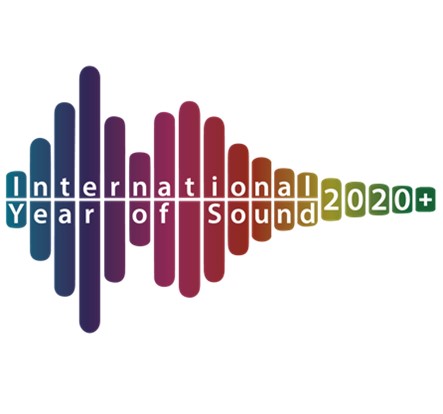
Introduction
During the nineteenth century and early years of the twentieth century, there were many news articles about anti-noise movements organized by groups in different US, Australian, and European cities. These movements were focused mainly on local problems. For some, this stance was for religious reasons, as they wanted a silent environment in which to pray to God. For others, they opposed noise to avoid sleep disturbance. However, the goal of this article is to describe the effort and actions of three anti-noise groups that were first to identify noise as a global issue, taking the stance that worldwide action was needed for its control.
The Early Technology for “Sound Measurement”
For centuries, musicians wanted to measure objectively sound’s physical characteristics. Philosophers, mathematicians, and physicists developed mechanical devices using rotating mirrors, flames, tuning forks, perforated wheels, strings with weights, and so on. But all of these tools were inaccurate. Another problem was the lack of standardized units for one universal way to measure sound levels.
It is believed that the first sound recording device was made by the French inventor Édouard-Léon Scott de Martinville, which he patented in 1857 as the phonautograph. A major limitation was that this device could not reproduce the sound that had been recorded. It was not until 1877 that Thomas Edison designed the first sound recording device, called the phonograph, which could reproduce the sound that it had recorded. In 1878, Edison developed a better version of his phonograph to measure the noise produced by the Metropolitan Elevated Railway of New York. This new device, the phonautograph, included a pencil attached to a horsehair and so was capable of drawing the sound wave on a cylinder in dotted lines (New York Times, “The Never-Tiring Edison,” July 12, 1878, p. 8). There are many publications about Edison’s pioneering work, but he nonetheless did not have a metric for his sound measurements.
The inventor Hiram Maxim (1840–1916) proposed “to measure” the sound level, as published in the San Francisco Call newspaper on August 11, 1895. This came about because he was called to be part of a legal dispute about noise emission from an electric power plant (see fig. 1). Like Edison, Maxim was seeking a standardized noise metric, and he proposed to compare the records from the phonometer for the power plant noise with the record from the sound of a lead shot dropped from 1 m.
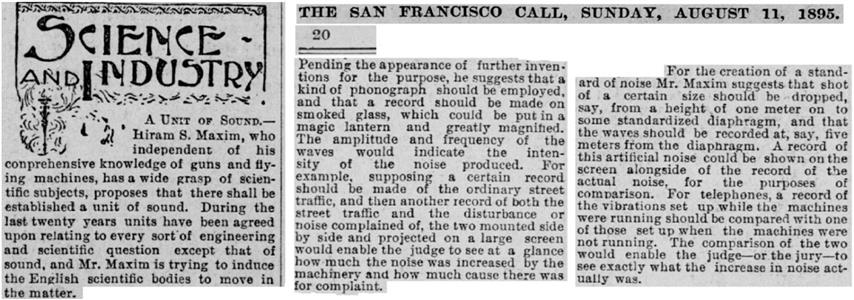
In December 1905, in Boston, a phonograph recording was admitted as evidence for the first time in US courts. The record was considered objective proof of a noise problem against the Boston Elevated Railroad. This case evidently had a big impact, as there were many reports about it in US newspapers. Ten years after Maxim considered a possible way to visualize the sound waves, a system using a phonograph, a photometer, and an oscillometer led to a substantial fine for the railroad company (see articles in fig. 2, published in 1906). Unfortunately, the names of the people who conducted these noise measurements are not known.
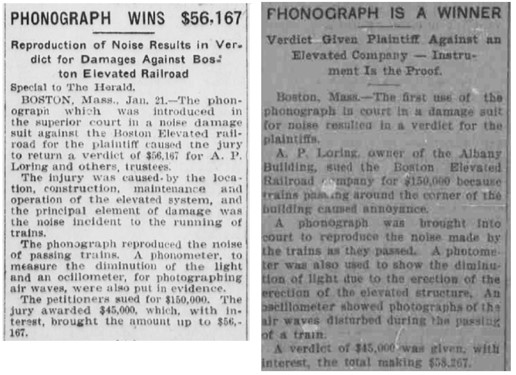
London’s Earliest Anti-noise Groups
From as early as the 1890s, an astonishing number of articles were disseminated in the medical press in England about the existence of anti-noise groups. Notwithstanding that there was no reliable instrumentation to measure sound levels, they put much emphasis on the need “to measure” the annoying noise and to counter its effect on mental disturbance, neurasthenia, and other psychological disorders.
The Association for the Suppression of Street Noises
In London in 1895, the Association for the Suppression of Street Noises (ASSN) was created, and this event is mentioned in December of the same year in the British Medical Journal (“Street Noises,” p. 1547), and a letter to the editor of the Times on December 5, 1895, is signed by Charles Fox, ASSN president. The Lancet, on May 28, 1898 (“Street Noises,” p. 1481), remarked on the ASSN’s work and the importance of this association. The ASSN presented to the home secretary, asking whether the government would take measures to introduce a bill dealing with street noises (Times, December 13, 1897, p. 4); however, there are no references of ASSN after 1899.
The Street Noise Abatement Committee
In March 1902, to take action politically, the Betterment of London Association (BLA) was formed (Saturday Review of Politics, Literature, Science, and Art, “Street Noises,” vol. 93, p. 359), and two months later the Street Noise Abatement Committee (Medical Record: A Weekly Journal of Medicine and Surgery 61, January 5–June 28, 1902, p. 662) was created as an offshoot of the BLA. Thomas Bowden Green and Sir Theodore Martin (1816–1909) were among their presidents.
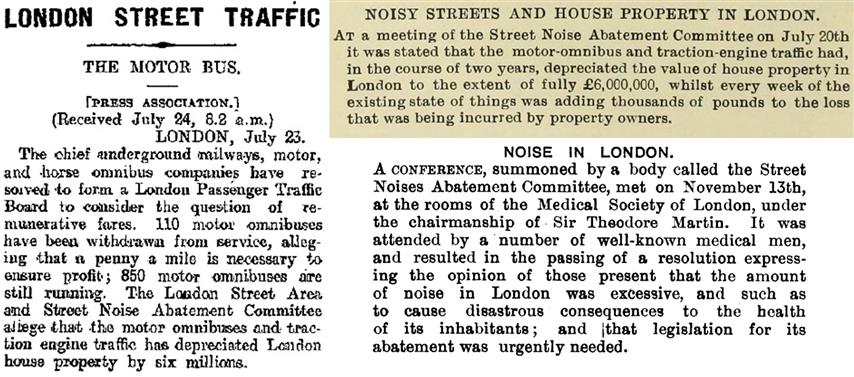
It is interesting how advanced knowledge about the problems from noise was in this period. In July 1907, these organizations estimated the depreciation of property, and many newspapers and others reproduced their report on “Noisy Streets and House Property in London” (fig. 3; Lancet 1907, p. 1481). Although the Street Noise Abatement Committee appears in the Trades Directory of 1914 (“Societies, Associations and Institutions,” p. 1923), there is no mention of it in the general media after 1911.
Society for the Suppression of Unnecessary Noise
In December 1906, the Society for the Suppression of Unnecessary Noise was formed by Julia Barnett Rice (1860–1929) in New York City (New York Daily, “Crusades on Noises,” December 4, 1906, p. 8; New York Times, “Mrs. Rice Now Attacks All Needless Noise,” December 9, 1906, p. 12; Thompson 2004, p. 121). There was worldwide media coverage of the society.
To demonstrate how annoying the noise from different sources could be, Rice involved students from Columbia Law School (known as “night owls”) to help. They recorded on gramophones dozens of noise samples (“canned noise,” as newspapers refer to them), and she used them for her presentations and meetings. On November 13, 1908, she opened a branch in Boston City, and during her conference at Hotel Vendome, she reproduced sounds with an interesting outcome: “After telling of her work Mrs. Rice turned on the canned noise to show its result. She got it sooner than expected, for after about three selections irate office tenants in nearby buildings telephoned wild calls for help to the Boston police. The canned noise was shut off hurriedly” (New York Tribune, “Canned Noise Effective,” November 14, 1908, p. 1).
Figure 4 shows images extracted from newspapers of different countries; for example, “The Phonograph as Evidence” was published on February 5, 1907, in the Herald of Melbourne.
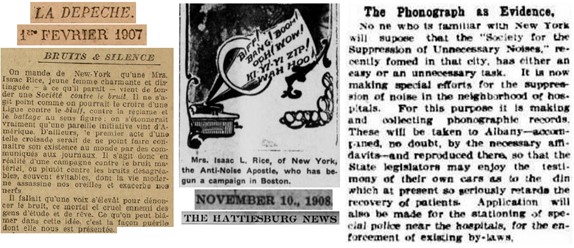
One important focus for Rice was the reduction of noise levels near hospitals. She was medically trained, so she knew that noise could have a negative influence on people who are recovering and could induce mental disturbance. There are many articles about Rice’s life and work that demonstrate she was a visionary. Among her proposals were acoustic zoning in cities, silent areas around hospital and schools, anti-noise bills, and special educational programs on the problems of unnecessary noises. She advocated worldwide action against noise by means of international meetings and congresses.

As one can observe in figure 5, humorists were aware of noisy cars back in 1902 and knew the importance of keeping quiet near hospitals. Rice’s efforts led to the first bill to create silent zones around hospitals in New York City in 1907.
Rice also started an “international rally,” visiting some European countries to discuss noise problems and how they affect human health, and she promoted the creation of local anti-noise societies. She traveled as far as Australia. The Critic from Hobart (Tasmania) on September 28, 1907, published the following: “Casual chat. New York has a Society for the suppression of unnecessary noise. Its president Mrs. L. Rice, is setting out on a world tour. There is a very general feeling that she should visit our fourteen Parliaments—they are responsible for a fearful amount of quite unnecessary noise”(p. 7). She was also focused on organizing an “international anti-noise convention,” and this took place in London in August 1909.
The German Anti-noise Society
The Deutscher Lärmschutzverbandsociety was created by Theodor Lessing (1872–1933) in Germany in 1908, inspired by Rice’s society (Goodyear 2011). Lessing was a very well-known philosopher committed to improving political and social problems, and noise was one of them (Baron 1982, p. 169). Lessing had a controversial view about noise and modernism. He published two anti-noise articles in 1901 and 1902, and “in his opinion, which clearly revealed Schopenhauer’s influence, the human desire to make noise emanated from an unconscious urge to repress self-consciousness and its awareness of the pain of existence” (p. 167).
He published the Der Antirüpel (The anti-rowdy) magazine as the official organ of his anti-noise society—after the first issue, the title was changed to Das Recht auf Stille (The right to quiet)—which served as a forum for every facet of his noise abatement movement (Baron 1982, p. 170).
Lessing’s descendants have made available his personals notebooks (Goodyear 2011), and these provide his thoughts on noise problems. He was not only concerned about noise in Germany but also sought a worldwide fight against unnecessary noises (Baron 1982, p. 175).
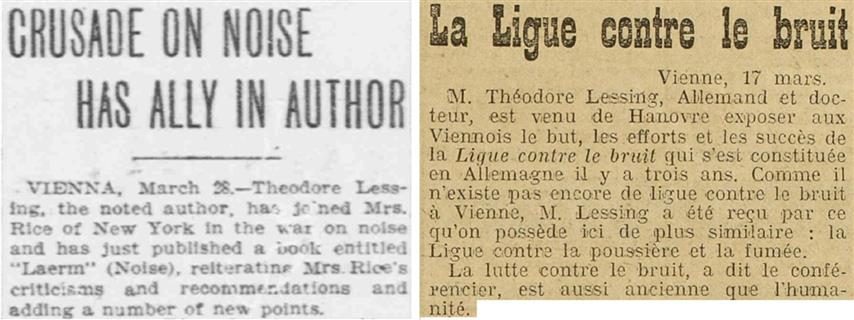
The First International Anti-noise Convention
On August 11–14, 1909, the First International Anti-noise Convention was held in London at the Ritz Hotel. This was organized by Julia Barnett Rice, and there are some articles mentioning that more than four countries “were present.” However, the records are limited, and they are mostly from German media. The only names that are known for sure (according to Lessing’s notebook) are Rice, Bowden Green (from the London society), and Lessing (Goodyear 2011). A resolution of this convention was “that an international effort to suppress unnecessary and objectionable noises should be made, that the attention of legislative and municipal authorities should be directed to the subject, and that the world’s Press be requested to accord its powerful support to a movement which cannot be otherwise than beneficial to the health and well-being of the community, and which is particularly necessary to teachers, students, and the professional classes” (Evening Star, Dunedin, New Zealand, November 11, 1909, p.7).

In Lessing’s notebook, he described the different sound identities of German and Austrian cities, which today would be described as “city soundscapes” (Goodyear 2011, p. 11). According to Goodyear, “Lessing seemed frustrated, however, by the statements of the other conference participants as they all said that the noise in their cities was by far the worst in the world” (p. 11). For the press, on the other hand, the debate was considered an interesting subject for discussion and provided short, exciting headlines. The Daily Mail (August 14, 1909) proclaimed that according to Rice, the “noisiest capitals” of the world were “Paris, followed by New York, London and Berlin” (Goodyear 2011, p. 11). It seems that the nonsensical discussion that is presented in the press even in the twenty-first century about “the noisiest cities in the world” had its origin in 1909. Regular international congresses were proposed to be held every two years, with the first one in Berlin in June 1910 and the second in New York City in 1912.
The First International Anti-noise Congress was canceled because Lessing did not have sufficient local support in Germany, and he was highly criticized by his political opponents. Later, Lessing abandoned his work against noise nuisance, and the Deutscher Lärmschutzverband withdrew from civil actions (Goodyear 2011). Finally, it was disbanded in 1914, before World War I (Baron 1982, p. 174).
The Second International Anti-noise Congress was due to take place in 1912 in New York, but from the lack of press coverage, it seems it did not proceed. There is no evidence of cancellation. However, in August of the same year, the Ninth International Otological Congress was held in Boston at Harvard Medical School, and there are some records referring to this congress as if it were an international anti-noise congress.
The Anti-noise Committee of the Baltimore City Medical Society
On October 18, 1912, right after the Boston Ninth International Otological Congress, the Anti-noise Committee of the Baltimore City Medical Society was created. Dr. William T. Watson, the chairman, directed an interesting campaign on “how each physician may help the anti-noise cause.” In 1911, efforts led to the passing of a bill in Baltimore to create a hospital zone law, though this only went into effect in 1913 when the street signs were erected (Bulletin of the Medical and Chirurgical Faculty of Maryland, January 1913).
The Baltimore Medical Society’s work resulted in six articles in the January 1913 issue of the Bulletin that discussed medical and legal aspects of noise problems, as shown in figure 8 (Bulletin, p. 94).

The Ligue Contre le Bruit in France
Following the “world tour” by Rice, a Ligue du silence was created in 1908 in Paris. Then in Le Gaulois, in the July 26, 1913, issue, an article reported the formation of theLigue contre le bruit (The league against noise), created in Paris with M. André Lebesgue as president and M. Jules Passihaut as vice president (see fig. 9).
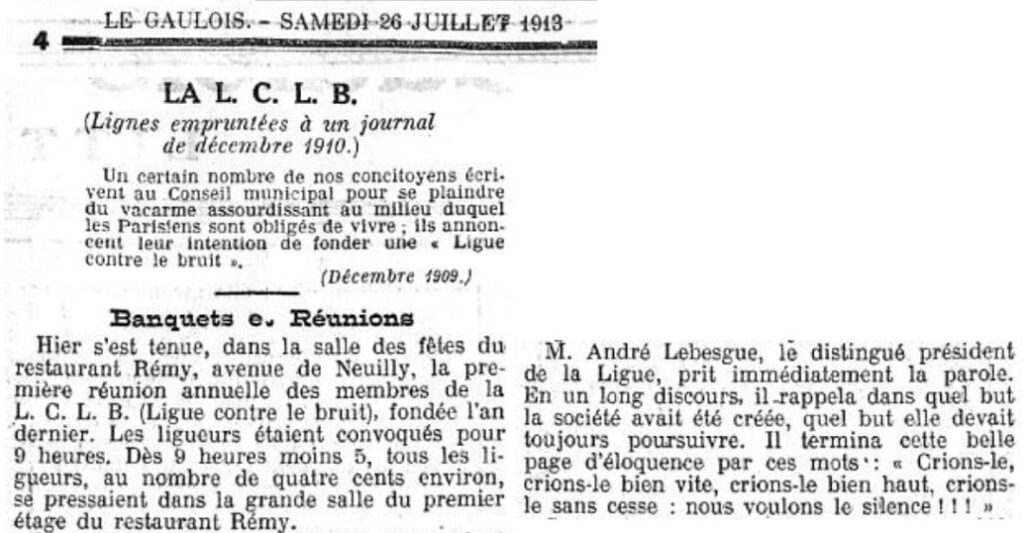
This article also mentions that in December 1909, some Parisians presented to the municipal council the intention to create an anti-noise league (Gallica 2020); it could be supposed that they may have been people who had a meeting with Rice in Paris.
Conclusion
The three 1900s anti-noise groups from different countries began a worldwide fight against unnecessary and annoying noise, raising the concern that noise is a health problem in cities and that it is important to find a solution to this problem through legal actions. However, the start of World War I in 1914 ended the work of all anti-noise groups. Nevertheless, the society started by Rice continued in New York City until her death in 1929. And the measurement of sound developed with the technology in the following decades. This enabled later government agencies and scientists to quantify noise levels, leading eventually to noise ordinances, noise limits, and policies. However, we should be grateful to the efforts of these early pioneers, in particular those of Rice, who was aware of the health effects of excess noise and took action to seek international collaboration to implement noise control.
Acknowledgments
The author wishes to thank Marion Burgess for encouraging, inviting, and assisting him to write this article; Eoin A. King and the board of NNI magazine for the opportunity to publish; and John Goodyear for providing his original article about Lessing’s travel to the London anti-noise conference as well as for clarifying some aspects of that conference.
About the Author
Walter Montano is an acoustician from Argentina who dedicates part of his free time to investigating the history of acoustics—in particular the development of awareness of the health effects of noise. Walter sources information from media and other sources that are freely available online from his base in Argentina and hence relies on the digitization of newspapers, magazines, and journals. It is acknowledged that any web searching protocol has limitations but that more historic material is being made available. Hence, there will always be discoveries of more content, and Walter welcomes any information that others may uncover.
Sources
Baron, L. 1982. “Noise and Degeneration: Theodor Lessing’s Crusade for Quiet.” Journal of Contemporary History 17, no. 1 (January): 165–178.
Gallica. 2020. Le Blog Gallica. https://gallica.bnf.fr/blog/?mode=desktop.
Goodyear, J. 2011. Lessing auf der Londoner Antilärmkonferenz. (Not available)
Thompson, E. 2004. The Soundscape of Modernity: Architectural Acoustics and the Culture of Listening in America, 1900–1933. Cambridge, MA: MIT Press.
Truth: A Weekly Journal. 1904. Vol. 56 (July to December).


